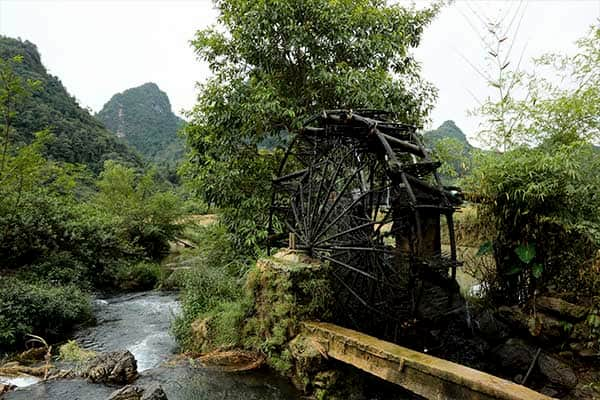BAN GIOC FALLS - NORTHERN VIETNAM
A REAL BREATH OF FRESH, RURAL AIR
The Ban Gioc waterfall is one of the most impressive natural sites in Vietnam. Located in the province of Cao Bang, in Northeast Vietnam, the falls are 30 metres high and 300 metres wide, making Ban Gioc the largest waterfall in the country. The falls occur on the Quay Son River, a beautiful jade blue stream of water that flows from China through a pastoral landscape of rice fields and bamboo trees. Despite improved road access and transport, Ban Gioc remains a relatively unusual sight in northern Vietnam and the country in general.
A brief history of the Ban Gioc Falls
Located between Vietnam and China, the Ban Gioc waterfall is a natural border in the north of Vietnam. The waterfall is divided into two parts, the northern part belonging to the territory of China and the other to Vietnam.
Although it is now generally accepted officially that falls are shared between the two countries, this has never been fully agreed. Many Vietnamese are convinced that the falls belong to them entirely. A stone marker on the south side of the falls indicates the boundary of Vietnamese territory, however some believe that this was moved during the 1979 Sino-Vietnamese war.
It is easy to forget that Cao Bang province was one of many points on the Vietnamese border where, in February 1979, Chinese forces entered Vietnam. The invasion had many reasons, but it was ultimately an extension of tensions between the Soviet Union and China (Vietnam having signed a treaty with the USSR in 1978). Thousands of Vietnamese and Chinese were killed and, when the Chinese army left (or withdrew), they devastated the lands they had briefly occupied. Along the road that follows the border, just after the falls, there are memorial sanctuaries dedicated to the Vietnamese people of the region who died in the 1979 war.
What to do in Ban Gioc?
The caves
There is an impressive network of limestone caves, the Nguom Ngao caves, a few kilometres to the right before reaching the Ban Gioc waterfall. A one-kilometre-long path leads through the caves, nicely lit and very impressive. Walk carefully because the path can be very slippery, with drops of calcium carbonate, which form stalactites.
Water wheels
Agricultural techniques have not changed much there for centuries: with the exception of a few mechanized rice threshers, most of the work is done by hand. You will see bamboo water wheels along the banks of the river. This attractive device draws water from the river, transports it to the fields and deposits it in earthen gutters, which carry it to the fields to irrigate the crops. It is a hypnotic, peaceful and timeless show.

Bamboo water wheels in Ban Gioc
The falls
You can simply buy a ticket (45,000 VND) at the kiosk before walking on a gravel road leading to the waterfall. Very rarely, the ticket office may ask to see your passport. The path crosses rice fields, passes over wooden bridges over gurgling streams and heads towards a grassy shoreline at the bottom of the falls. The wide white waterfall is bordered by foliage and framed by sharp, tooth-like limestone mountains, partially masked by clouds from all the spray generated by the waterfall. The newly constructed hill-top temple and pagoda are located on the south side of the road, in front of the falls.
Bamboo rafts and swimming
Bamboo rafts (50,000 VND per person) bring visitors closer to the waterfall for a better view. The walk lasts about 10 minutes and you will certainly get wet. It is difficult to resist diving into one of the blue puddles, especially around the small waterfalls to the left of the central waterfall. In general, there is no one to stop you from taking a bath but, of course, you must be very careful: stay in the calm rocky basins and stay away from the main waterfall.
Some tips during your stay in Ban Gioc
According to residents and travellers, the best time to visit this waterfall is around August and September, when the water is strong, clear and blue. If you want to enjoy the fantastic view of the rice fields of Cao Bang, visit it in October. Or visit November and December if you want to admire the beauty of the wild sunflower fields after exploring the Ban Gioc waterfall. Take these elements into account in order to plan your trip to North Vietnam in the best possible way.



